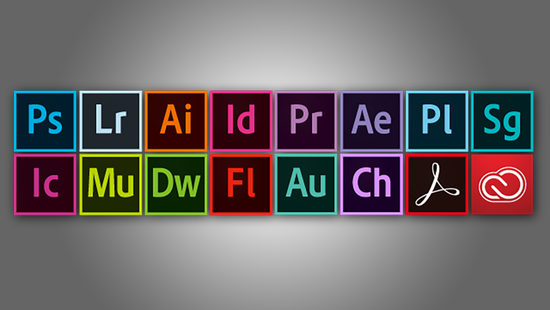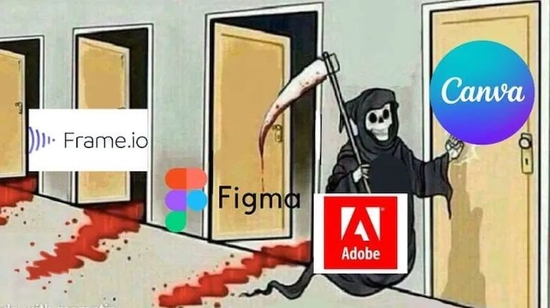your current location is:Home > investHomeinvest
The $20 billion "selling body" giant, Figma is not the "ultimate way out" for SaaS

The dragon slayer may not necessarily become a dragon, but may also be the "new redemption" of the dragon.
Author | Luo Ning Editor | Jing Yu
Source: Geek Park
On September 15th, the ten-year and one-month-old design platform Figma was acquired by the four-year-old software giant Adobe.
The price of $20 billion set a record for the valuation of the C-side SaaS field - just a year ago, Figma's valuation was only $10 billion, and its annual revenue just reached $400 million, which means its transaction price has been 50 times annual recurring revenue (ARR).
Interestingly, apart from Figma's investors, no one seems to be optimistic about the "combination" of the two companies: the financial community believes that Adobe may have to borrow in order to complete the acquisition, so that Adobe's stock price fell 17% instantly; Figma users I am worried that the SaaS subscription, which has always been "approachable", will follow Adobe after being acquired by the giant and immediately wave the butcher's knife to cut the leeks.
In addition to the "unrejectable price" offered by the giants, "the dragon slayer finally became the evil dragon horse boy" and other social media stalks. What does Adobe's acquisition of Figma mean for the booming SaaS track? Will this acquisition start a wave of giants acquiring vertical SaaS companies?
 Figma co-founder Dylan Field becomes Silicon Valley's youngest billionaire after acquisition | Figma
Figma co-founder Dylan Field becomes Silicon Valley's youngest billionaire after acquisition | Figma01
The "unicorn" that grows on the browser
The rapid growth of Figma is a story that catches the wind. There are three key words in the wind: collaboration, HTLM5 and SaaS.
Figma was founded in 2012 by two Brown University students, Dylan Field and Evan Wallace, initially not sure what the product they were trying to create would function, but they Seeing the trend of the times: At that time, with the announcement of the first draft of HTML5 in 2008, browsers such as Chrome and Firefox began to generally support HTML5, and the concept of "cross-platform" began to innovate.
Based on many new features, HTML5 has become a new technology trend, allowing a series of cloud-based Internet services such as Google Wave and Google Docs to exist on any device with the help of a browser. Before HTML5 appeared, this matter was very Hard to do.
The idea of Dylan Field and Evan Wallace gradually emerged. Because of the cross-platform advantages of HTML5, they can create a design tool that everyone can use. This is a product that is missing in the market and is the core of Figma's product, as they said externally. As: "Figma should be directly in the browser, it's a free, simple, and creative tool that anyone can use to get creative with it."
However, the team is still difficult to determine the details of how Figma will be presented. Therefore, Figma, which has just been established, faces the continuous departure of its members, and its operation is in a quagmire of crisis.
The opportunity for change came when Dylan was looking for seed round investment. When he found John Lilly, a well-known Silicon Valley venture capital firm Greylock investor, and hoped to get investment, John found that the problem with Figma was that the product planning direction was not clear enough, and he suggested that Dylan “can go to Ask Adobe CEO Bruce Chizen for advice", this woke up Dylan, he was quick to do it and got a revelation, no one would have thought that this would be the beginning of Figma's disruptive design field.
 Figma is completely browser-based and supports cross-platform collaboration|Figma
Figma is completely browser-based and supports cross-platform collaboration|FigmaThe Figma team determined that the product needed to provide browser-based UI/UX design collaboration capabilities and should include all the design capabilities of traditional software to enable multi-person editing between designers and cross-functional non-design teams. After continuous experience and functional improvements to Figma by attracting 1,000 early users, the product achieves important features that differentiate it from previous design software:
Compared to Adobe XD, Figma has better team collaboration features, it simplifies the design process and effectively helps designers and teams collaborate more effectively, allowing all members of the team to collaborate in real time, it's free and works with any Platform, collaboration is simple and flexible. Embedded files provide real-time updates, prototyping is simple and intuitive, developer handoff is easy, and team libraries are ideal for designing systems, allowing anyone with access to use the latest version. Best of all, by opening up its API, Figma allows anyone to build plugins, templates or tools.
As a result, Figma took off, and people found that compared to its competitors, whether Adobe XD, Sketch or InVision, Figma is easier and more convenient to use, and as its official website says, it is a design tool based on collaboration. , getting rid of localization and platform constraints, and offering free premium services to educators, gives Figma the opportunity to attract more users in the SaaS space.
On Figma's official website, there was such a passage: "Don't use Adobe XD to sync to the cloud, use Figma to work in the cloud."
A survey of prototyping tools shows that the continuous growth of Figma since its release has given Adobe, Sketch, and InVision enough pressure to your opponents. By 2022, the proportion of users using Figma has exceeded 50%. Therefore, It's not hard to see why Adobe bought Figma for an "astronomical" $20 billion.
Another detail that supports Figma's rapid growth is its partnership with Microsoft.
Microsoft and Adobe have had a very friendly partnership for decades, and they also have cloud-based design software Xamarin in-house, but after Figma came along, tens of thousands of employees inside Microsoft became increasingly reliant on Figma.
In an interview in August, Jon Friedman, vice president of design and research at Microsoft for 18 years, said Figma was "like air and water" for teams.
 Microsoft and Figma work closely together, and the team is very active in the Figma developer community | Figma
Microsoft and Figma work closely together, and the team is very active in the Figma developer community | FigmaIn fact, within Microsoft, not just designers, but engineers, marketers, and data scientists use Figma to connect team members in India, China, Europe, and the U.S. through the platform. Friedman even In 2017, I found Field and proposed that Figma should charge a fee and provide more functions. With the help of the giant, Figma developed a premium package version designed for top enterprises, which made a positive contribution to its continuous increase in revenue in the SaaS field.
A collaborative cross-platform tool + a vibrant open source community, coupled with the high efficiency of continuously deepening into vertical fields according to the needs of enterprises, have enabled Figma to achieve rapid growth in just five years.
According to reports, Figma’s revenue in 2020 has reached 75 million US dollars, and the estimated revenue scale in 2021 is close to 150 million US dollars, and the valuation in 2021 will reach 10 billion US dollars, which is 100 times the revenue.
In 2020, Adobe added Figma to its list of competitors published in its annual report.
02
Giants make up "new blood"
As a veteran company in Silicon Valley, Adobe, founded in 1982, can still stand in the leading camp in the field of design services. long transition period.
Over the past decade, Adobe's stock has risen tenfold to as high as $320 billion. But Adobe stock has fallen more than 40% over the past year. Its main business is based on the core of cloud services and switched to a subscription model. When dividing the business structure, Adobe is divided into three parts according to different areas: digital media (Digital Media), digital marketing (Digital Marketing), publishing and printing (Print & Publishing).
Among them, the digital media business as the main revenue part includes two parts, namely Adobe Creative Cloud (ie Adobe CC) and Adobe Document Cloud (Adobe DC), while in the digital marketing part, it includes Adobe Experience Cloud (Adobe EC).
 Adobe family bucket, the current cash flow mainly depends on CC (Creative Cloud) | Adobe
Adobe family bucket, the current cash flow mainly depends on CC (Creative Cloud) | AdobeIn the process of transformation and upgrading, the traditional publishing and printing businesses are gradually declining, replaced by the above three business lines, and the two businesses that really allow Adobe to stand above the market value of hundreds of billions of dollars are its Creative Cloud and Experience Cloud. Line - Obviously, the advent of Figma has shaken the foundation of the Creative Cloud line of business.
The initial impact of Figma was not obvious, Adobe's deep design skills, so it can still attract many users, especially enterprise customers. But the rising price of Creative Cloud as its main product, combined with the widening gap between Adobe XD in the collaboration space and Figma, which has a growing community and massive free plug-in support, has had an impact on Adobe.
Beginning in 2020, with the arrival of the new crown epidemic, global enterprises have opened a new model of remote work from home, which has boosted the popularity of Figma worldwide.
With its browser-based UI/UX design collaboration capabilities, Figma continues to attract users from the design, creative and even marketing fields, which has led to its whiteboard collaboration product, FigJam. With the support of the thriving community ecosystem, Figma has also attracted companies including Microsoft, Twitter, Airbnb, Dropbox, etc. Even in China, giants such as DJI are also using it, which really opened the gap between Figma and Adobe XD difference.
Greylock, a top Silicon Valley VC who has participated in Figma's early investment, has sorted out the "User Engagement Hierarchy Theory" for evaluating a company's development, which includes three levels:
One: increase participating users;
Two: retain users;
Three: Realize a virtuous circle.
While most companies in Silicon Valley are focused on user growth and "growth hacking," Greylock believes that what really matters is not how user growth is done, but the core operations that complete the product.
For Figma, the core action is that users share the content that needs to be collaborated and get the support of others. In this matter, Figma has done a good enough job that it is difficult for other competitors to catch up.
In a January interview, analysts asked Adobe executives about Figma, discussing whether Figma was taking market share that once belonged to Adobe, but Scott Belsky, head of product at Adobe and executive vice president of Creative Cloud, Belsky) did not directly answer the question.
But he acknowledged that venture capital has been pouring money into the space, and Adobe would use the opportunity to bring Creative Cloud to the web.
In this interview, Adobe didn't talk about any plans for Adobe XD, other than saying that the company will discuss it at its October meeting. It turns out that Adobe at that time had realized the necessity of acquiring Figma. Even if it was just to eliminate hidden dangers, Adobe had to make a move, and to pay 50 times ARR for this, it was necessary to take Figma into the bag.
03
Assimilation or "improvement"?
For overseas users, this sky-high acquisition is bad news.
Some people believe that when a family of high-spirited, sword-wielding dragon slayers is bought by old-school bureaucrats and treasure-guarded dragons, dragon slayers will no longer be what they once were. There are countless stalks about acquisitions on the Internet. For example, the icon of Figma will become a purple box FG of Adobe's family bucket.
 Creators will not give up "playing memes" while crying | Twitter
Creators will not give up "playing memes" while crying | TwitterOthers argue that it's time to find the next Figma, and Adobe's charging strategy will make Figma an expensive tool away from educators and individual users.
But in Field's view, it's not too early to come to a conclusion.
He said in the open letter: "Utilizing Adobe's technology, expertise and resources in the creative field, we have a huge opportunity to accelerate the development and innovation of the Figma platform. For example, we will have the opportunity to combine them in imaging, photography, illustration, video, Expertise in 3D and typography technology is integrated into the Figma platform. Plus, we will have the opportunity to reimagine the look and feel of the best creative tools in the Figma technology stack.”
At the same time, Field also emphasized that Adobe is committed to keeping Figma operating independently, so services for education are still free. As a $20 billion acquisition of the "hot fried chicken," letting Figma continue to move forward and propel Adobe to the next level, which, as Field puts it, will be "a platform to help Adobe build the next generation of creative tools." Rare opportunity".
But for Adobe, how to integrate Figma is indeed a problem. After all, they already have Adobe XD, which directly targets Figma. It is still unknown whether they will merge the two into a new Figma, or allow Figma to continue to operate independently. The fate of Figma will only be known when the deal closes in 2023.
In the past two years, SaaS companies have grown rapidly due to the epidemic. Whether it is office, logistics, education, there are countless teams in all walks of life, aiming at the pain points of vertical industries to start businesses in the direction of SaaS.

Different from C-end consumer business entrepreneurship, B-end SaaS entrepreneurship not only requires the team to have a deep understanding of industry issues, but also tests the ability to serve B-end users.
From this perspective, established software companies need the innovation of SaaS teams; while startups also need the experience that giants have accumulated on the B-side over the years.
The acquisition of Figma by Adobe may not necessarily set off a wave of old software companies acquiring SaaS teams. But it undoubtedly sets a fairly high target and ceiling for the SaaS team, proving once again the value of innovation, or the price of giants' "elimination of hidden dangers" may be very high.
On the other hand, if the introduction of Figma this time can allow the old giants to start their transformation from "cloud" to "collaborative SaaS", and then make A company "great again", then the $20 billion is not a "high price", It's just "a little expensive transition cost".
And this test is not only the determination to pay, but the courage to transform again.
related articles
Article Comments (0)
- This article has not received comments yet, hurry up and grab the first frame~












